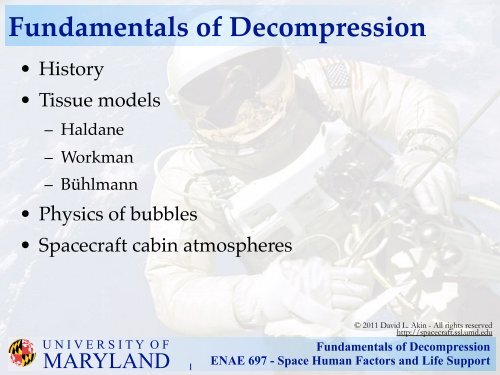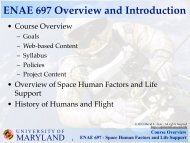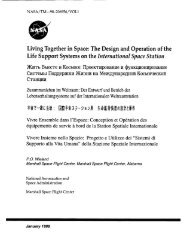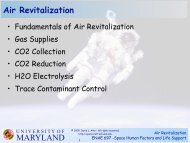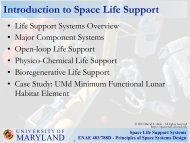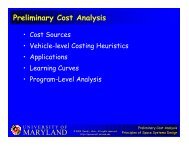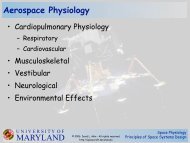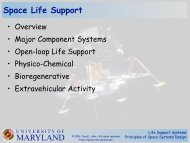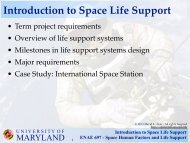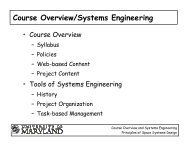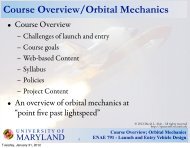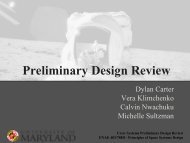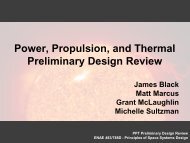Fundamentals of Decompression
Fundamentals of Decompression
Fundamentals of Decompression
Create successful ePaper yourself
Turn your PDF publications into a flip-book with our unique Google optimized e-Paper software.
<strong>Fundamentals</strong> <strong>of</strong> <strong>Decompression</strong><br />
• History<br />
• Tissue models<br />
– Haldane<br />
– Workman<br />
– Bühlmann<br />
• Physics <strong>of</strong> bubbles<br />
• Spacecraft cabin atmospheres<br />
U N I V E R S I T Y O F<br />
MARYLAND<br />
1<br />
© 2011 David L. Akin - All rights reserved<br />
http://spacecraft.ssl.umd.edu<br />
<strong>Fundamentals</strong> <strong>of</strong> <strong>Decompression</strong><br />
ENAE 697 - Space Human Factors and Life Support
First Class Assignment<br />
• Four topics in the first section <strong>of</strong> the course<br />
– Space Habitability<br />
– Human Factors<br />
– Anthropometrics<br />
– Psychosocial Aspects<br />
• Find a technical paper in two <strong>of</strong> the topic areas<br />
• Post the paper (in PDF) and a summary (~0.5-1<br />
page) to discussion board on Blackboard<br />
• No duplication! There’s an advantage in being first<br />
• Due Thursday March 3rd<br />
U N I V E R S I T Y O F<br />
MARYLAND<br />
2<br />
<strong>Fundamentals</strong> <strong>of</strong> <strong>Decompression</strong><br />
ENAE 697 - Space Human Factors and Life Support
Discussion <strong>of</strong> Term Project<br />
• Please go to Blackboard site and list team members<br />
(and innovative team names) for all teams<br />
• First phase: design interior layout <strong>of</strong> X-Hab in<br />
configuration for 2011 test series<br />
– Accommodations for four crew<br />
– Diagrams coming for outer envelope<br />
• Submit as slide package (no presentation) by<br />
March 18 (i.e., before Spring break)<br />
• Second phase: full interior layout <strong>of</strong> two layers<br />
with life support and habitat elements<br />
U N I V E R S I T Y O F<br />
MARYLAND<br />
3<br />
<strong>Fundamentals</strong> <strong>of</strong> <strong>Decompression</strong><br />
ENAE 697 - Space Human Factors and Life Support
Caissons<br />
U N I V E R S I T Y O F<br />
MARYLAND<br />
4<br />
• Pressurized chambers<br />
for digging tunnels and<br />
bridge foundations<br />
• Late 1800’s - caisson<br />
workers exhibited<br />
severe symptoms<br />
– joint pain<br />
– arched back<br />
– blindness<br />
– death<br />
<strong>Fundamentals</strong> <strong>of</strong> <strong>Decompression</strong><br />
ENAE 697 - Space Human Factors and Life Support
Brooklyn Bridge<br />
U N I V E R S I T Y O F<br />
MARYLAND<br />
• Designed by John Roebling, who<br />
died from tetanus contracted<br />
while surveying it<br />
• Continued by son Washington<br />
Roebling, who came down with<br />
Caisson Disease in 1872<br />
• Competed by wife Emily<br />
Warren Roebling<br />
• 110 instances <strong>of</strong> caisson disease<br />
from 600 workers<br />
5<br />
<strong>Fundamentals</strong> <strong>of</strong> <strong>Decompression</strong><br />
ENAE 697 - Space Human Factors and Life Support
<strong>Decompression</strong> Sickness (DCS)<br />
• 1872 - Dr. Alphonse Jaminet noted similarity<br />
between caisson disease and air embolisms<br />
• Suggested procedural modifications<br />
– Slow compression and decompression<br />
– Limiting work to 4 hours, no more than 4 atm<br />
– Restricting to young, healthy workers<br />
• 1908 - J.B.S. Haldane linked to dissolved gases in<br />
blood and published first decompression tables<br />
U N I V E R S I T Y O F<br />
MARYLAND<br />
6<br />
<strong>Fundamentals</strong> <strong>of</strong> <strong>Decompression</strong><br />
ENAE 697 - Space Human Factors and Life Support
Supersaturation <strong>of</strong> Blood Gases<br />
• Early observation that “factor <strong>of</strong> two” (50% drop in<br />
pressure) tended to be safe<br />
• Definition <strong>of</strong> tissue ratio R as ratio between<br />
saturated pressure <strong>of</strong> gas compared to ambient<br />
pressure<br />
R = PN2<br />
Pambient<br />
• 50% drop in pressure corresponds to R=1.58<br />
(R values <strong>of</strong> ~1.6 considered to be “safe”)<br />
U N I V E R S I T Y O F<br />
MARYLAND<br />
=0.79 (nominal Earth value)<br />
7<br />
<strong>Fundamentals</strong> <strong>of</strong> <strong>Decompression</strong><br />
ENAE 697 - Space Human Factors and Life Support
Tissue Models <strong>of</strong> Dissolved Gases<br />
• Issue is dissolved inert gases (not involved in<br />
metabolic processes, like N2 or He)<br />
• Diffusion rate is driven by the gradient <strong>of</strong> the<br />
partial pressure for the dissolved gas<br />
dPtissue(t)<br />
dt<br />
where k=time constant for specific tissue (min -1 )<br />
P refers to partial pressure <strong>of</strong> dissolved gas<br />
U N I V E R S I T Y O F<br />
MARYLAND<br />
= k [Palveoli(t) − Ptissue(t)]<br />
8<br />
<strong>Fundamentals</strong> <strong>of</strong> <strong>Decompression</strong><br />
ENAE 697 - Space Human Factors and Life Support
Tissue Saturation following Descent<br />
U N I V E R S I T Y O F<br />
MARYLAND<br />
11<br />
<strong>Fundamentals</strong> <strong>of</strong> <strong>Decompression</strong><br />
ENAE 697 - Space Human Factors and Life Support
Tissue Saturation after Ascent<br />
U N I V E R S I T Y O F<br />
MARYLAND<br />
12<br />
<strong>Fundamentals</strong> <strong>of</strong> <strong>Decompression</strong><br />
ENAE 697 - Space Human Factors and Life Support
Effect <strong>of</strong> Multiple Tissue Times<br />
U N I V E R S I T Y O F<br />
MARYLAND<br />
13<br />
<strong>Fundamentals</strong> <strong>of</strong> <strong>Decompression</strong><br />
ENAE 697 - Space Human Factors and Life Support
Haldane Tissue Models<br />
• Rate coefficient frequently given as time to evolve<br />
half <strong>of</strong> dissolved gases:<br />
T 1/2 =<br />
• Example: for 5-min tissue, k=0.1386 min -1<br />
• Haldane suggested five tissue “compartments”: 5,<br />
10, 20, 40, and 75 minutes<br />
• Basis <strong>of</strong> U. S. Navy tables used through 1960’s<br />
• Three tissue model (5 and 10 min dropped)<br />
• 1950’s: Six tissue model (5, 10, 20, 40, 75, 120)<br />
U N I V E R S I T Y O F<br />
MARYLAND<br />
ln (2)<br />
k<br />
14<br />
k =<br />
ln (2)<br />
T 1/2<br />
<strong>Fundamentals</strong> <strong>of</strong> <strong>Decompression</strong><br />
ENAE 697 - Space Human Factors and Life Support
Workman Tissue Models<br />
• Dr./Capt. Robert D. Workman <strong>of</strong> Navy<br />
Experimental Diving Unit in 1960’s<br />
• Added 160, 200, 240 min tissue groups<br />
• Recognized that each type <strong>of</strong> tissue has a differing<br />
amount <strong>of</strong> overpressure it can tolerate, and this<br />
changes with depth<br />
• Defined the overpressure limits as “M values”<br />
U N I V E R S I T Y O F<br />
MARYLAND<br />
15<br />
<strong>Fundamentals</strong> <strong>of</strong> <strong>Decompression</strong><br />
ENAE 697 - Space Human Factors and Life Support
Workman M Values<br />
• Discovered linear relationship between partial<br />
pressure where DCS occurs and depth<br />
M=partial pressure limit (for each tissue compartment)<br />
M0=tissue limit at sea level (zero depth)<br />
ΔM=change <strong>of</strong> limit with depth (constant)<br />
d=depth <strong>of</strong> dive<br />
U N I V E R S I T Y O F<br />
MARYLAND<br />
M = M0 + ∆Md<br />
• Can use to calculate decompression stop depth<br />
dmin = Pt − M0<br />
∆M<br />
16<br />
<strong>Fundamentals</strong> <strong>of</strong> <strong>Decompression</strong><br />
ENAE 697 - Space Human Factors and Life Support
PADUA (Univ <strong>of</strong> Penn.) Tissue Model<br />
Tissue T 1/2 (minutes) M 0 (bar)<br />
1 5 3.040<br />
2 10 2.554<br />
3 20 2.067<br />
4 40 1.611<br />
5 80 1.581<br />
6 120 1.550<br />
7 160 1.520<br />
8 240 1.490<br />
9 320 1.490<br />
10 480 1.459<br />
U N I V E R S I T Y O F<br />
MARYLAND<br />
17<br />
<strong>Fundamentals</strong> <strong>of</strong> <strong>Decompression</strong><br />
ENAE 697 - Space Human Factors and Life Support
Bühlmann Tissue Models<br />
• Laboratory <strong>of</strong> Hyperbaric Physiology at University<br />
Hospital, Zurich, Switzerland<br />
• Developed techniques for mixed-gas diving,<br />
including switching gas mixtures during<br />
decompression<br />
• Showed role <strong>of</strong> ambient pressure on<br />
decompression (diving at altitude)<br />
• Independently developed M-values, based on<br />
absolute pressure rather than SL depth<br />
• “Zurich” 12 and 16-tissue models widely used<br />
U N I V E R S I T Y O F<br />
MARYLAND<br />
18<br />
<strong>Fundamentals</strong> <strong>of</strong> <strong>Decompression</strong><br />
ENAE 697 - Space Human Factors and Life Support
Bühlmann M-Value Models<br />
• Modifies Workman model by not assuming sea<br />
level pressure at water’s surface<br />
M = Pamb<br />
+ a<br />
b<br />
Pamb=pressure <strong>of</strong> breathing gas<br />
b=ratio <strong>of</strong> change in ambient pressure to change in tissue<br />
pressure limit (dimensionless)<br />
a=limiting tissue limit at zero absolute pressure<br />
• ZH-L16 model values for a and b<br />
a =2T<br />
− 1<br />
3<br />
1/2<br />
U N I V E R S I T Y O F<br />
MARYLAND<br />
< bar > b =1.005 − T − 1<br />
2<br />
1/2<br />
19<br />
<strong>Fundamentals</strong> <strong>of</strong> <strong>Decompression</strong><br />
ENAE 697 - Space Human Factors and Life Support
Physics <strong>of</strong> Bubbles<br />
• Pressure inside a bubble is balanced by exterior<br />
pressure and surface tension<br />
Pinternal = Pambient + Psurface = Pambient + 2γ<br />
where γ=surface tension in J/m 2 or N/m (=0.073 for water<br />
at 273°K)<br />
• Dissolve gas partial pressure Pg=Pamb in<br />
equilibrium<br />
• Gas pressure in bubble Pint>Pamb due to γ<br />
• All bubbles will eventually diffuse and collapse<br />
U N I V E R S I T Y O F<br />
MARYLAND<br />
20<br />
<strong>Fundamentals</strong> <strong>of</strong> <strong>Decompression</strong><br />
ENAE 697 - Space Human Factors and Life Support<br />
r
Critical Bubble Size<br />
• Minimum bubble size is defined by point at which<br />
interior pressure Pint = gas pressure Pg<br />
2γ<br />
• rrmin - bubble will grow<br />
• r=rmin - unstable equilibrium<br />
U N I V E R S I T Y O F<br />
MARYLAND<br />
rmin =<br />
21<br />
Pg − pambient<br />
<strong>Fundamentals</strong> <strong>of</strong> <strong>Decompression</strong><br />
ENAE 697 - Space Human Factors and Life Support
Bubble Formation and Growth<br />
• In equilibrium, external pressure balanced by internal<br />
gas pressure and surface tension<br />
• Surface tension forces inversely proportional to radius<br />
U N I V E R S I T Y O F<br />
MARYLAND<br />
22<br />
<strong>Fundamentals</strong> <strong>of</strong> <strong>Decompression</strong><br />
ENAE 697 - Space Human Factors and Life Support
“Clinical” Discussion <strong>of</strong> DCS<br />
• Tissue models are predictive, not definitive<br />
• Every individual is different<br />
– Overweight people more susceptible to DCS<br />
– Tables and models are predictive limits - there will be<br />
“outliers” who develop DCS while adhering to tables<br />
• Doppler velocimetry reveals prevalence <strong>of</strong> bubbles<br />
in bloodstream without presence <strong>of</strong> DCS<br />
symptoms - “asymptomatic DCS”<br />
U N I V E R S I T Y O F<br />
MARYLAND<br />
23<br />
<strong>Fundamentals</strong> <strong>of</strong> <strong>Decompression</strong><br />
ENAE 697 - Space Human Factors and Life Support
Implications <strong>of</strong> DCS in Space Flight<br />
• Drop from sea level pressure to ~4 psi, 100% O2<br />
pressure<br />
– Equivalent to ascent from fully saturated 120 ft dive<br />
– Launch in early space flight<br />
– Extravehicular activity from shuttle or ISS<br />
R = PN2<br />
Pamb<br />
• To have “safe” (R=1.4) EVA from shuttle requires<br />
suit pressure <strong>of</strong> 8.2 psi<br />
U N I V E R S I T Y O F<br />
MARYLAND<br />
24<br />
= 14.7(0.78)<br />
4<br />
=2.87<br />
<strong>Fundamentals</strong> <strong>of</strong> <strong>Decompression</strong><br />
ENAE 697 - Space Human Factors and Life Support
Current Denitrogenation Approaches<br />
• Depress to 10.2 psi for 12-24 hours prior to EVA<br />
– Full cabin depress in shuttle<br />
– “Campout” in air lock module <strong>of</strong> ISS<br />
• Exercise while breathing 100% O2<br />
• In-suit decompression on 100% O2 (3.5-4 hours)<br />
U N I V E R S I T Y O F<br />
MARYLAND<br />
25<br />
<strong>Fundamentals</strong> <strong>of</strong> <strong>Decompression</strong><br />
ENAE 697 - Space Human Factors and Life Support
Historical Data on Cabin Atmospheres<br />
from Scheuring et. al., “ Risk Assessm ent <strong>of</strong> Physiological Effects <strong>of</strong> Atm ospheric Com position and Pressure<br />
in Constellation Vehicles” 1 6th Annual Humans in Space, Beijing, China, May 2007<br />
U N I V E R S I T Y O F<br />
MARYLAND<br />
26<br />
<strong>Fundamentals</strong> <strong>of</strong> <strong>Decompression</strong><br />
ENAE 697 - Space Human Factors and Life Support
Spacecraft Atmosphere Design Space<br />
from Scheuring et. al., “ Risk Assessm ent <strong>of</strong> Physiological Effects <strong>of</strong> Atm ospheric Com position and Pressure<br />
in Constellation Vehicles” 1 6th Annual Humans in Space, Beijing, China, May 2007<br />
U N I V E R S I T Y O F<br />
MARYLAND<br />
27<br />
<strong>Fundamentals</strong> <strong>of</strong> <strong>Decompression</strong><br />
ENAE 697 - Space Human Factors and Life Support
Effect <strong>of</strong> Pressure and %O2 on Flammability<br />
from Hirsch, William s, and Beeson, “ Pressure Effects on Oxygen Concentration Flam m ability Thresholds <strong>of</strong><br />
Materials for Aerospace Applications” J. Testing and Evaluation, Oct. 2006<br />
U N I V E R S I T Y O F<br />
MARYLAND<br />
28<br />
<strong>Fundamentals</strong> <strong>of</strong> <strong>Decompression</strong><br />
ENAE 697 - Space Human Factors and Life Support
Atmosphere Design Space with Constraints<br />
from Scheuring et. al., “ Risk Assessm ent <strong>of</strong> Physiological Effects <strong>of</strong> Atm ospheric Com position and Pressure<br />
in Constellation Vehicles” 1 6th Annual Humans in Space, Beijing, China, May 2007<br />
U N I V E R S I T Y O F<br />
MARYLAND<br />
29<br />
<strong>Fundamentals</strong> <strong>of</strong> <strong>Decompression</strong><br />
ENAE 697 - Space Human Factors and Life Support
Constellation Spacecraft Atmospheres<br />
from Scheuring et. al., “ Risk Assessm ent <strong>of</strong> Physiological Effects <strong>of</strong> Atm ospheric Com position and Pressure<br />
in Constellation Vehicles” 1 6th Annual Humans in Space, Beijing, China, May 2007<br />
U N I V E R S I T Y O F<br />
MARYLAND<br />
30<br />
<strong>Fundamentals</strong> <strong>of</strong> <strong>Decompression</strong><br />
ENAE 697 - Space Human Factors and Life Support


